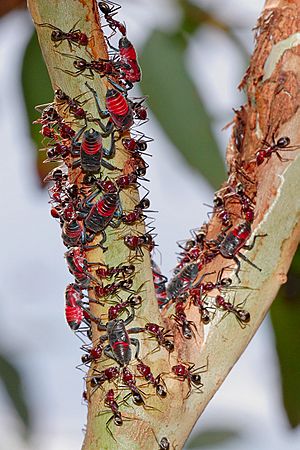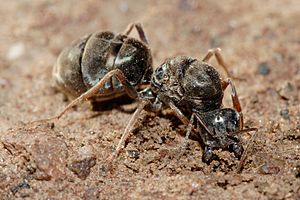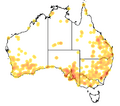Meat ant facts for kids
Quick facts for kids Meat ant |
|
|---|---|
 |
|
| Meat ant | |
| Conservation status | |
|
Not evaluated (IUCN 3.1)
|
|
| Scientific classification | |
| Kingdom: | |
| Phylum: | |
| Class: | |
| Order: | |
| Family: | |
| Subfamily: |
Dolichoderinae
|
| Tribe: |
Leptomyrmecini
|
| Genus: | |
| Species: |
I. purpureus
|
| Binomial name | |
| Iridomyrmex purpureus (Smith, 1858)
|
|
| Synonyms | |
|
|
Meat ants (Iridomyrmex purpureus) are a type of ant found all over Australia. People also call them 'meat-eater ants' or 'gravel ants'. They belong to a group of ants called Iridomyrmex.
Contents
What's in a Name?
The scientific name for the meat ant is Iridomyrmex purpureus. The word purpureus comes from Latin. It means "purple" or "dark-red". This describes the ant's color.
The name of their group, Iridomyrmex, means "rainbow ants". This is another hint about their look. They have a cool blue-green, shiny color that looks like a rainbow. The word Irido means "rainbow" in Ancient Greek, and myrmex means "ant".
How Meat Ants Live
Finding Food

Meat ants are active during the day. They are a very common and strong group of ants in Australia. They are busy, tough, and live all over the country.
During the day, worker ants visit insects like leafhoppers on Eucalyptus trees. These insects give off a sweet liquid called honeydew. Meat ants love this sugary treat.
The ants make clear paths, called foraging trails, to their favorite trees. These trails are easy to see because there is no grass or plants on them. These paths help the ants find food and water, especially on hot, dry days. Some trails also lead to other nests that are part of the same colony. These are called satellite nests.
Other worker ants search for dead insects or other food to bring back to their main nest. Meat ant nests are usually in sunny spots. This helps the nest stay warm. The warmer it is, the faster the ants move. Foraging ants leave the nest after the sun has warmed it up in the morning.
What Meat Ants Eat

Meat ants eat many different things, just like other Iridomyrmex ants. They eat insects like caterpillars and butterfly larvae. They also hunt bigger animals. For example, they prey on Crucifix toads as they change from tadpoles. They also take eggs and young from tiny wasps.
Meat ants will swarm trees to attack giant lacewings. They also eat Indianmeal moths and Almond moths. On sandy beaches, they hunt a type of worm called Armandia intermedia. They cause many of these worms to die.
While they love honeydew, flower nectar, and other sweet things, meat ants also eat dead snakes, lizards, birds, and other insects. Sometimes, they even eat dead foxes. Meat ants are the only ants in Australia known to eat guano (bat or bird droppings).
Who Eats Meat Ants?

Even though meat ants are strong, many animals eat them. The Short-beaked echidna (Tachyglossus aculeatus) is a main predator. Echidnas especially like to eat the queen ants because they have a lot of fat. Queens can be almost half fat! If there are no queens, an echidna might stop attacking the nest.
Echidnas dig into the ant nests to eat the queens. They can handle the ant bites, even scratching themselves on their head and chest. Echidnas in Canberra only attack meat ant nests from August to October. This is when new queen ants with wings fly out of the nest. It's easier for echidnas to catch them then.
Several birds also eat meat ants. The Masked woodswallow and White-browed woodswallow fly around the nests. They swoop down to catch and eat the ants. Parts of meat ants have been found in the stomachs of other birds too, like the Red-capped robin. Large birds that feed on the ground, such as Currawongs, Magpies, and Ravens, will dig up new ant colonies. They find these new nests by the small piles of dirt the ants dig out. Many young queens are eaten by these birds.
A type of blind snake called Ramphotyphlops nigrescens follows meat ant trails. They might do this to find the ants to eat. These snakes also eat the young ants (brood).
Some spiders like to eat meat ants. They are drawn to a special smell (alarm pheromone) that the ants release. One spider, Habronestes bradleyi, is a special hunter of meat ants. It uses the ants' alarm smell to find them during fights.
Moths of the genus Cyclotorna, especially Cyclotorna monocentra, eat meat ant young. The young moths are parasites of leaf-hoppers. They move into meat ant colonies to finish growing. There, they eat the ant young. Female moths lay eggs near ant trails where leaf-hoppers are.
Other insects also interact with meat ants. The young of the moth Iphierga macarista are scavengers in meat ant nests. Sphallomorpha beetles live in burrows near meat ant nests. Their young can be found in the nests, where they catch and eat passing worker ants.
The young of the Spitfire sawfly can spit a fluid at meat ants if attacked. Depending on how much fluid is spit, the ant might just walk away and clean itself, or it could die. Some lizards, like the Thorny devil, eat meat ants. But other lizards that eat Iridomyrmex ants usually avoid this specific species.
Life Cycle and Reproduction
New queen ants and male ants with wings fly out of the nest to mate. This usually happens in spring, around October. It happens after it rains. The males fly out first, then the new queens. Groups of 20 to 40 female ants gather after the males have flown away. They sit on top of the nest to get warm. Once they are warm, they all fly at the same time. This can happen many times unless the weather changes. If it does, the queens go back into the nest. This mating flight continues for days until all the new queens have left the nest.
A single queen usually starts her own colony. She lays eggs that take about 44 to 61 days to grow into adult ants. Sometimes, several queens work together to start a colony. Or, a queen might be adopted into an existing colony. Another way new colonies form is by "budding." This is when a part of the colony, including queens, workers, and young ants (eggs, larvae, and pupae), moves to a new nest site. About 10% of queens will have at least one other queen with them when starting a new colony.
Many queens die when trying to start a colony. Birds and other ants, even other meat ants, can eat them. This often happens because they try to build their nests near large colonies. However, some queens are successful. Sometimes, nearby worker ants will even help and protect the queen. They might also help her dig chambers. Other reasons queens die include sickness and not having enough food. A queen's ovaries (where eggs are made) take about four weeks to get ready. She will then lay about 20 eggs. These eggs can become larvae in less than a month. Worker ants have also been seen laying eggs, which are likely food for the colony.
A full-grown meat ant nest can be several years old. It can hold between 11,000 and 64,000 ants. Some estimates say up to 300,000 ants! These large colonies can have almost 70,000 larvae, 64,000 workers, 20,000 males, and over 1,000 new queens. Sometimes, there are more new queens than males.
Most meat ant colonies have only one queen. This is called monogyne. But some nests can have more than one queen. Some nests have two queens, and a few even have four queens in one colony. In some colonies, multiple queens live together and are accepted by all the workers, even if the workers were born from different queens. The queens are treated equally. This acceptance continues even when new queens and males are born. However, queens and workers can tell which young ants are theirs. Queens will only take care of their own young and ignore young laid by other queens.
Queens will work together when starting a nest. But once there are workers, they might become less friendly with each other. As the colony grows, queens become more intolerant. They might separate within the nest, and each queen will lay more eggs. This often happens if multiple queens start a colony together, or if a queen joins an existing colony. Physical fights between queens in the same colony are rare.
Meat ants are a polydomous species. This means they live in more than one nest. Workers from the same colony who live in different nests can sometimes be aggressive toward each other.
Ritual Fighting
Meat ants are very protective of their territory. They are also aggressive. They set up clear boundaries around other colonies. These boundaries are not physical lines. Instead, worker ants keep them by having "ritual fights" with ants from other colonies. Most colonies do this.
These fights rarely cause deaths, but sometimes a worker might get hurt. Meat ants have learned to use ritual fighting to settle arguments over territory. This way, colonies can fight over land without killing many ants on both sides. It helps them avoid losing too many ants and helps them communicate. If these fights didn't happen, the borders would be constant battle zones, weakening the colonies. Deadly fights only happen if a colony is under a real attack.
A fight between two worker ants lasts about 15 seconds. Ritual fights only happen when two worker ants meet. If both ants are from the same colony, the fight stops, and they clean themselves. Then they walk around until they meet another ant.
A meat ant knows if another worker is from a different colony by touching it with its antennae a lot and opening its jaws wide. They also stretch themselves up to look taller and bigger. This suggests that meat ants try to show off their size. Workers also do a move called "front leg boxing." Both ants sweep their front legs up and down. This lasts about three to five seconds. This move helps decide who is the "loser" and who is the "winner."
The ant that loses the ritual fight will lower its body. It will lean sideways away from the winning ant. The winning ant stays tall. It reaches down to the other ant, opens its jaws wider, and gently grabs the losing ant's jaws. It then shakes its head slightly for a short time.
Sometimes, ritual fights continue if neither ant gives up. They will stand side-to-side, raise their bodies, and circle each other. They point their rear ends (gasters) at their opponent. Sometimes, one or both ants will kick each other with their legs. Eventually, they stop fighting and clean themselves once they have settled the dispute. Then they continue looking for other ants.
Meat Ants and Other Living Things
Meat ants have been seen blocking the holes of banded sugar ant nests with small stones and dirt. This stops the sugar ants from leaving their nest early in the day. The sugar ants fight back by blocking the meat ants' holes with debris.
If trees or shade cover a meat ant nest, banded sugar ants might take over. This is because the meat ant colony might get weaker from the shade. The meat ants then move to a nearby satellite nest in a better spot. The invading sugar ants fill the old nest tunnels with a black sticky material.
Meat ants usually don't like other creatures living in their colonies. But Cyclotorna larvae and some beetles have been found living in their nests. Other types of ants and even termites sometimes use empty parts of meat ant colonies.
Meat ants can kill poisonous cane toads. Cane toads are a pest that was brought to Australia. The poisons that usually kill animals that eat cane toads do not hurt meat ants. When attacked, a cane toad usually stands still, letting its poison work. This allows the meat ants, who are not affected, to easily attack and eat the toad.
In the countryside of Australia, meat ants are helpful to farmers. Farmers put dead animal bodies on their nests. In a few weeks, the ants will have eaten the entire body, leaving only bones.
However, meat ants can sometimes be a problem. They might come into human houses to find food. Their nests can also disturb the soil. This can be annoying if nests are built on gravel paths, tennis courts, or other clear areas. Getting rid of nests can be hard. This is because a rival colony or nearby unaffected nests can quickly refill the area. Some meat ant species have adapted well to cities. In the early days of Canberra, new neighborhoods gave meat ants many new places to build nests, and their numbers grew. Other things that help them are gardens and plantations with lots of food.
Images for kids
-
A meat ant mound near Bungendore, New South Wales.
-
A worker ant with a common jassid nymph. These insects make a sugary sap that the ants collect, and the ants protect this valuable food source.
See also
 In Spanish: Hormiga de la carne para niños
In Spanish: Hormiga de la carne para niños
















